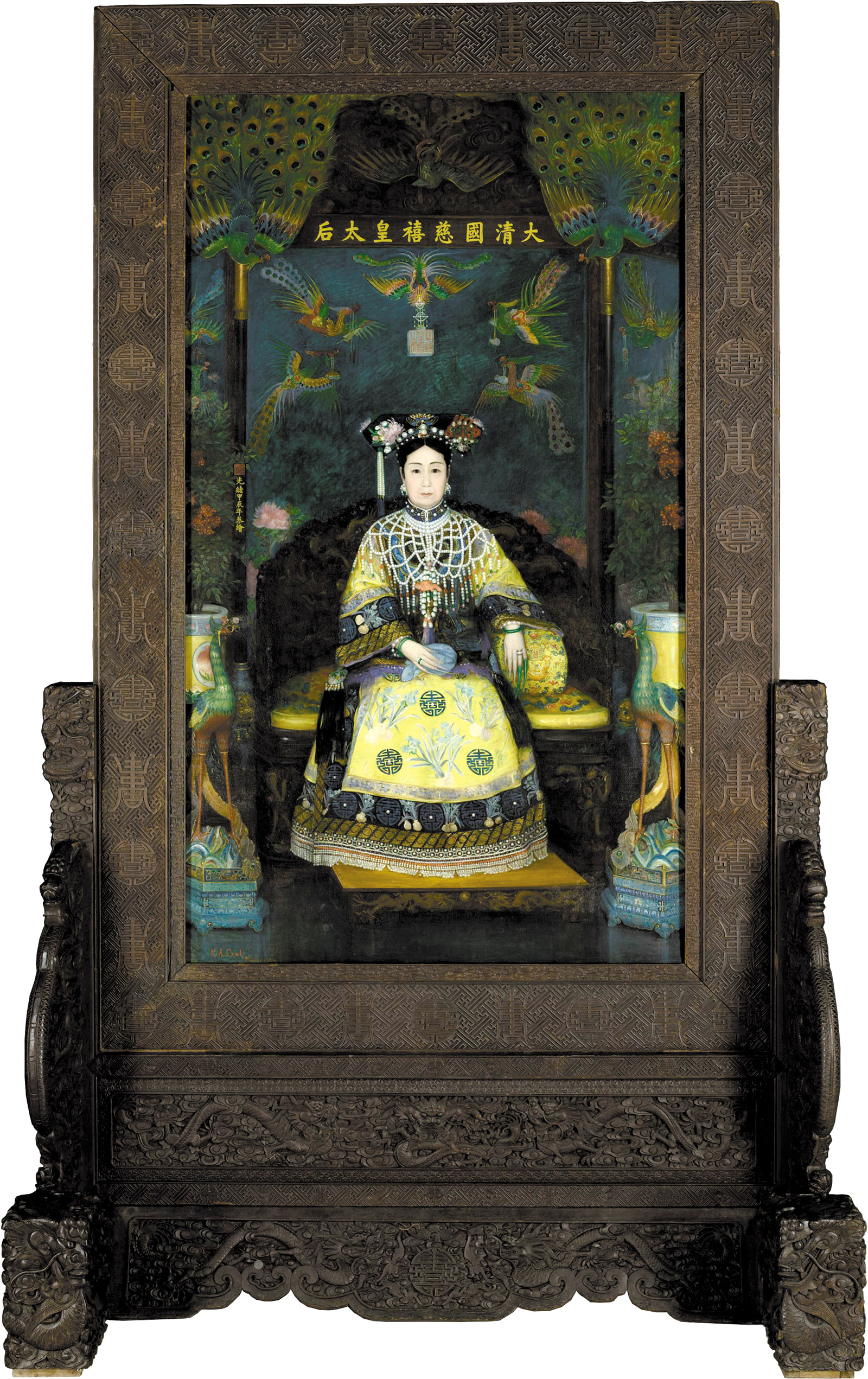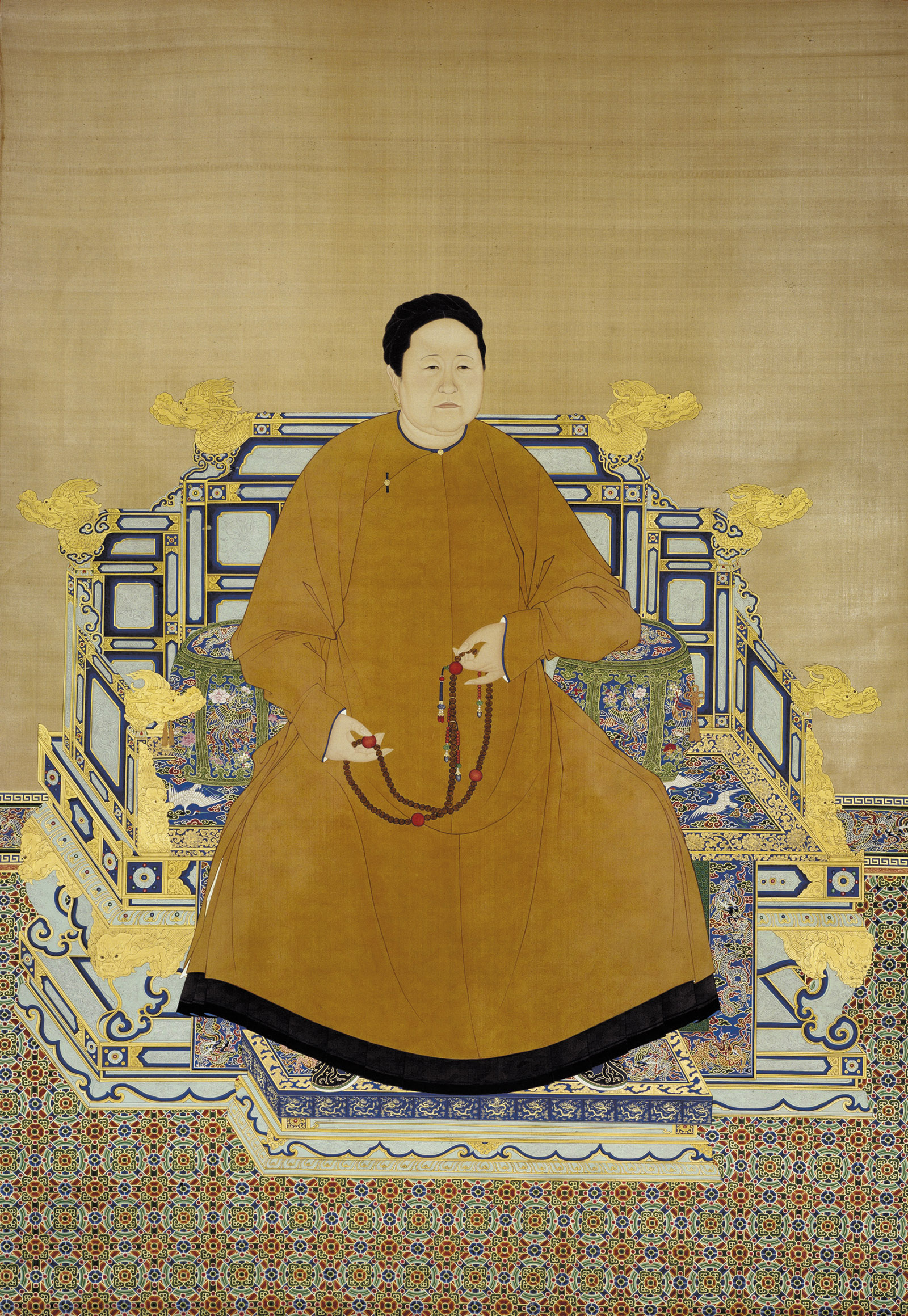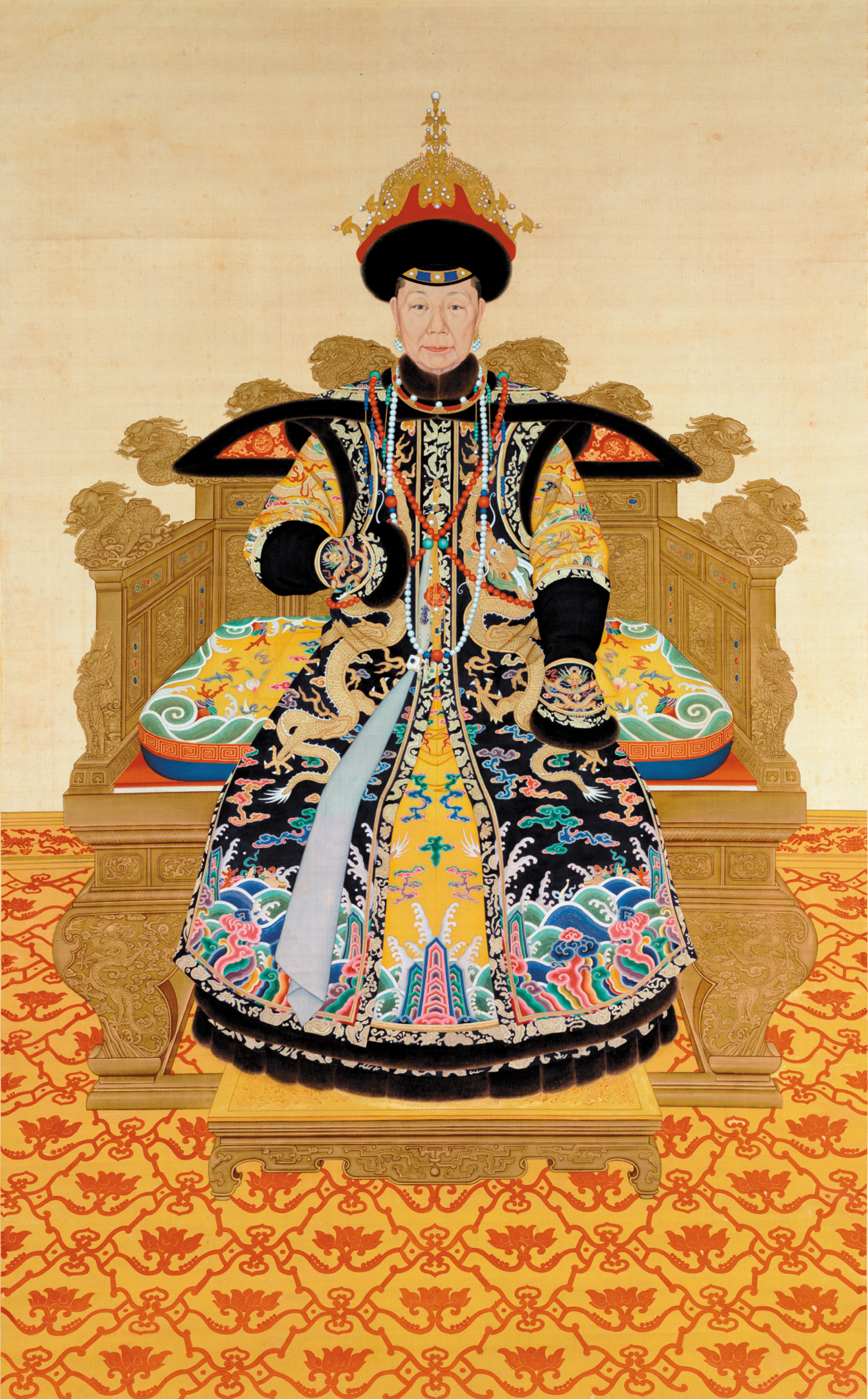An enormous portrait of the Chinese empress dowager Cixi, arguably the most powerful woman in Chinese history, stands in the entrance hall of the Sackler Gallery as an introduction to “Empresses of China’s Forbidden City, 1644–1912,” an exhibition of more than two hundred objects from the Palace Museum in Beijing that marks the fortieth anniversary of the establishment of diplomatic relations between the US and the People’s Republic of China. Painted by the American artist Katharine Carl, the portrait was sent with great ceremony to be displayed at the St. Louis World’s Fair in 1904 and eventually entered the collection of the Smithsonian.
American journalists of the time reported on Carl’s work on the portrait in Beijing, as well as its journey to St. Louis by train and steamship via Shanghai, Honolulu, and San Francisco, accompanied by an honor guard of one hundred attendants. The Pacific Commercial Advertiser of Honolulu described the excitement surrounding its arrival that May, observing that until then, few had “any real conception of the features of the woman who has become famous in modern history.” Less charitably, the New-York Daily Tribune mentioned in a feature on the artist that the empress dowager had been accused of “most of the sins” in the Ten Commandments, referring to rumors that she had, among other things, committed murder in order to seize the throne. Other Western newspapers described Cixi as “a she tiger” when referring to her unprecedented domination of the Qing dynasty’s court and policies since 1861.
Carl had received the commission for the portrait at the suggestion of Sarah Pike Conger, the wife of the American ambassador, Edwin Hurd Conger. The Congers were eager to improve US–China relations after the damage caused by the anti-foreign Boxer Uprising of 1900, which the empress dowager had supported. By developing a friendship with Cixi after it had been suppressed and the court was able to return to the palace in 1902, Mrs. Conger aided her husband’s diplomatic efforts to protect and promote American commercial interests in China. She convinced Cixi to grant Carl—who was in China to visit her brother Francis, an officer of the Chinese Maritime Customs service and the Chinese vice commissioner of the St. Louis fair—the privilege of an audience and eventually multiple sittings over nearly a year as a way to improve the empress dowager’s negative international image.
Despite her celebrity—or notoriety—few in this country today know much about Cixi or any other imperial women from Chinese history. The exhibition’s curators, Daisy Yiyou Wang, the Robert N. Shapiro Curator of Chinese and East Asian Art at the Peabody Essex Museum, and Jan Stuart, the Melvin R. Seiden Curator of Chinese Art at the Freer and Sackler Galleries, explain in the catalog that China’s last imperial dynasty, which ruled from 1644 to 1912, had more than two dozen empresses, all of them technically “inalienable possessions” of the emperor. They lived under strict codes that forbade them from being seen in public and limited their social and political opportunities. Despite the Qing court’s obsession with recording every aspect of palace affairs relating to the emperor, little was noted about the women surrounding him. Wang and Stuart’s thoughtful selection of sumptuous objects made for the empresses of the Qing dynasty allows us to speculate about the degree to which they were able to shape their world.
The portrait of Cixi is a study in contradictions. Although it has a massive physical presence—in its frame it stands nearly seventeen feet high and weighs more than 1,200 pounds—the figure appears rather diminutive. The empress dowager’s youthful and even gentle-looking face seems to belie her frequent depiction as a caricature of evil in the American press. But the portrait is also full of symbols of power. Cixi is wearing bright yellow, a color reserved for the highest-ranking members of the court, including the emperor, the empress dowager, and the empress. Nine phoenixes, which were associated with the palace, float around her.
Illustrations accompanying contemporary newspaper accounts of the portrait’s transport to St. Louis indicate that Cixi arranged for its outer crate to be draped in yellow silk emblazoned with giant dragons holding flaming pearls, another symbol of imperial authority. The portrait’s intricate frame is carved with more dragons, as well as multiple stylized characters for longevity, as if to shout, “Long live the queen!” The artist told reporters after her return to the United States that Cixi was very much involved in determining how she was to be represented: she was keen to guide her own—and China’s—public relations campaign.
Cixi came to power first as regent for her young son, the Tongzhi emperor, who was only five when his father, the Xianfeng emperor, died in 1861. When Tongzhi unexpectedly died thirteen years later, Cixi chose her four-year-old nephew to become the Guangxu emperor. She would control him and the imperial court until her death in 1908. Guangxu died the same year. China would have only one more emperor, Cixi’s grandnephew Xuantong, better known as Puyi (the subject of the 1987 film The Last Emperor, directed by Bernardo Bertolucci).
Advertisement
Cixi’s power toward the end of the Qing dynasty was unusual, for China had a long-standing tradition that “women shall not rule.” Her strength of will and political savvy were no doubt responsible for the status she attained, but there was also a precedent at the beginning of the dynasty. In the exhibition there is a portrait of Empress Xiaozhuang, who was married to the Qing founder, Hong Taiji, and bore his heir, the Shunzhi emperor; it is nearly as large as the one Cixi sent to St. Louis. Unlike Cixi, however, Xiaozhuang wielded power through influence rather than as the regent of either her son or her grandson the Kangxi emperor.
The portrait of Xiaozhuang, which was painted nearly one hundred years after her death in 1688, differs in several ways from traditional Qing portraiture intended for ancestor worship (see illustration to the right). Most significantly, her pose is typical of a man. An emperor is usually depicted with his splayed feet in boots showing beneath his robe. His hands are also visible. Both men and women could wear boots at the Qing court (and an elegant women’s pair is on display in the exhibition), but women’s portraits rarely show their extremities. Xiaozhuang’s feet in decorated boots peek out from under her robe, and her bare hands finger her court necklace. Both details indicate that this empress’s status, like Cixi’s, may have resembled that of the emperor.*
The position in Chinese society held by Xiaozhuang, Cixi, and the other empresses highlighted in the exhibition derived from their being mothers. Cixi entered the palace as a consort of the sixth rank but rose to fourth and then third after having a son, and she gained her title of empress dowager after her husband’s death because her son had been selected to succeed him. Except during a brief period in the late seventeenth and early eighteenth centuries, any of the emperor’s consorts could advance their position by giving birth to a son, no matter what position they had when they entered the court, and the emperor could designate any of his sons as the heir to the throne. An emperor’s open devotion to his mother, in the form of frequent visits, gifts, and elaborate festivities in her honor, was celebrated as a model for good government and a means of maintaining the natural order of the cosmos.
A large and elaborate five-panel cloisonné screen on display in the exhibition illustrates this idea of natural order. Once believed to have belonged to an emperor because of its size and quality, Wang and Stuart propose that it must have been placed behind the chair of an imperial woman because it was listed in the inventory of a palace residence for widowed Qing consorts. The panels of multicolored enamels set in golden wire depict an imaginary landscape in which a pair of phoenixes rule over an avian empire. In addition to presenting traditional symbols like cranes (for longevity) and mandarin ducks (for marital harmony), this scene as a whole signifies the five basic relationships whose proper arrangement was critical to maintaining social order: those of parent and child, ruler and minister, husband and wife, senior and junior, and among friends.
Various species of birds righteously ruled by a pair of imperial phoenixes must have been a reassuring metaphor for the Qing leaders, who had to exert control over a diverse multiethnic population. As Evelyn Rawski writes in her catalog essay, the Qing were Jurchen, northeast Asian people from Jianzhou, outside the Great Wall and separated from the Han Chinese they conquered. They spoke a different language and practiced different customs. Their women did not bind their feet and were known to travel, ride horses, practice archery, and hunt alongside men. In 1636 the Qing leader designated his people as Manchus, purposefully distinguishing them from the Han.
By the time of the Qianlong emperor, who reigned from 1736 to 1795, Qing society was thought to encompass five peoples: Manchus, Mongols, Chinese, Tibetans, and Uighurs. In order to gain the loyalty of warriors from different cultures and then to maintain power over a vast territory bigger than today’s China (including what is now Mongolia), the ruling Manchus carefully crafted and projected a distinct self-identity, yet they shrewdly adopted aspects of Chinese culture that supported their rule and enabled them to live in peace with their subjects. Upholding attitudes about social order, including a son’s filial piety toward his mother, was part of such efforts.
Advertisement
We know about another empress featured in the exhibition, the empress dowager Chongqing (see illustration below), largely because of the acts of filial piety performed by her son, the Qianlong emperor. Chongqing entered court as a servant in 1704, when she was eleven years old, and gave birth to her only child seven years later. Her husband, the Yongzheng emperor, promoted her to third-rank consort after he secretly selected her son to succeed him. Her son gave her the titles of empress and empress dowager after he ascended to the throne. Qianlong visited his mother daily to inquire about her health and took her with him on several official tours and pilgrimages.
The largest room of the exhibition is devoted to motherhood and includes one of four long handscrolls Qianlong commissioned to celebrate Chongqing’s sixtieth birthday in 1751. It depicts the festivities sponsored by various government departments, signaling the relationship between the state and the emperor’s devotion to his mother. Throngs of people line the streets to see exotic animals, horse riders, and opera performances in the open air or in both Chinese- and Western-style festival structures. The finely detailed paintings took twenty-nine court painters nearly ten years to complete, and Qianlong was able to present them to his mother on her seventieth birthday. She lived to be more than eighty, so her son had to give her a great many more presents, including a multivolume set of Buddhist scriptures displayed in another room of the exhibition.
When daughters from elite Manchu families reached the age of twelve or thirteen, they were presented to the palace in Beijing so the imperial family could have first pick before their fathers considered other matches for them. Some girls might become a primary wife; others might be chosen as lower-ranking consorts for a prince or the emperor himself. It was probably a misunderstanding of this custom that led some American newspapers to spread the notion that Cixi’s father had sold her into slavery. In reality, she entered the palace the usual way, if only as a consort of lower rank.
A set of painted album leaves showing the 1889 marriage of the Guangxu emperor takes up a small room in the exhibition. The emperor and his bride, Empress Xiaoding, do not appear except for one view of the emperor from the back, but the state performance of their relationship is indicated by the elaborate ceremonies surrounding their union. One painting shows the bride’s father and retinue being feted by the emperor’s representatives for raising a virtuous woman who would influence the ruler positively and become the mother of the state.
Another painting shows the empress’s entourage traveling from her parents’ home to the palace. Unlike commoner women when they married, the empress would never visit her home again. The Manchus ensured that she severed ties with her own family and transferred her loyalty to that of her husband. In return, the emperor showered her with gifts, sending them to her home with great ceremony (as depicted in another painting from the album). The gifts traveled back to the palace with the empress for her use, thereby avoiding an unwanted distribution of wealth and the influence of in-laws that could come with it.
A portable censer produced for the 1872 wedding of the Tongzhi emperor (Cixi’s son) and Empress Xiaozhe (Cixi’s niece) is a particularly beautiful example. One imagines that it might have been carried in a procession, emitting scent from the burning incense within, the dangling bells attached by chains jingling softly. Made of gold and rich zitan wood, it is covered in auspicious symbols appropriate for a newly married imperial couple: dragons and phoenixes (for the balance of yin and yang), a wish-granting scepter, a gourd (for fertility), and a double-happiness symbol (for marital harmony).
The room with the wedding gifts includes some of the most spectacular objects in the exhibition: Empress Xiaoding’s clothing and accessories. Her red wedding robe is decorated with eight large roundels, each with a double-happiness character, a dragon, and a phoenix. On the robe’s hem, waves full of bobbing treasures indicate riches, and mountains signal the terrestrial realm in which the emperor was the axis mundi, with the empress supporting his place in the cosmos.
Xiaoding’s wedding ensemble may have also included the headdress displayed nearby. Bearing similarly auspicious symbols of phoenixes, bats, fishes, and the double-happiness character, it is made of gilt silver and decorated with iridescent kingfisher feathers set in gold wire, as well as pearls, coral, rubies, and other precious stones. Even in the display case, the decorations on the headdress move slightly as visitors pass, just as they must have followed the movements of its original wearer.
One wonders how difficult it might have been for the empress to perform the rituals of her wedding ceremony dressed in heavily embroidered brocade and with such delicately constructed splendor perched on her head. The catalog describes how she was carried in a palanquin to the Forbidden City but then had to exit carrying a golden wish-granting scepter (also on display) in one hand and an apple in another. At the Gate of Heavenly Purity, she met a group of Manchu noblemen’s wives and exchanged the gold scepter for a vase full of gems conveying wishes for wealth. Once in the palace, the empress had to first step over a lit brazier in a Manchu ritual intended to exorcise evil spirits, and then over a saddle, another expression of Manchu identity. The apple in her hand, and another two set under the saddle, were part of a symbolic program that indicated wishes for peace.
Love could arise in such arranged official marriages. One of the most moving objects in the exhibition is a long elegiac poem written in the Qianlong emperor’s own hand on paper usually reserved for Buddhist sutras, describing his devastation at the loss of his beloved wife Empress Xiaoxian. He extols her goodness and virtue and expresses surprise over how quickly time has passed since her death. Looking at new things only intensifies his suffering; old things only serve to remind him of happier times. The poem ends with the emperor visiting her chambers:
When entering her bedroom,
I inhale sadness.
I climb behind her phoenix
bed-curtains,
Yet they hang to no avail.
The romance of the spring breeze
and autumn moon
All ends here.
Summer days and winter nights
spent with her
Will never come again.
After such an appeal to romantic imperial love, the paintings of exemplary empresses from history and other role models of womanly behavior in the next room, though exquisitely made, seem didactic. Other rooms display some of the accoutrements of empress-style living, including exquisitely made cosmetics boxes, washbasins, and tableware in porcelain, enamel, lacquer, gold, or silver. One case shows how the color of an imperial consort’s dishes depended on her rank. While monochrome yellow was reserved for the emperor, empress dowager, and empress, lower-ranking consorts dined from dishes in yellow and blue or purple and green.
A room in the exhibition dedicated to “a full and active life” and Stuart’s essay in the catalog attempt to dispel the idea that palace women had their identities erased or that they led languid, unfulfilling lives. She argues that even though the empress, empress dowager, and other consorts could not be seen by men other than close family members or eunuchs, they were physically and socially active. Several objects in the exhibition make reference to their pursuits, including a handscroll of an imperial woman on horseback handing an arrow to the Qianlong emperor as he shoots a deer. Others show court women performing rites to promote silkworm culture, celebrating annual festivals, and participating in competitions related to needlework. Two paintings from a set of twelve depicting individual women in richly appointed garden residences are, according to Stuart, best understood as portraits of real court consorts that were enhanced with traits borrowed from well-established Chinese conventions for images of “beauties” or even courtesans, especially since the women are in informal and somewhat seductive dress. Commissioned by the Yongzheng emperor when he was still a prince, the paintings must have been intended for his personal viewing, if in fact they are portraits of imperial women.
The last room is devoted to the influence of empresses on religious life and their involvement in politics and diplomacy. Qing empresses participated in and even shaped many spiritual practices at court. Their promotion of Tibetan Buddhism in particular provided a means by which the Manchu rulers of the Qing dynasty could ensure that their Tibetan and Mongol subjects would accept their rule.
A painting of Cixi as the bodhisattva Guanyin is both strange and intriguing in its combination of sacred and secular identities. But it is Chongqing, or at least her son’s devotion to her, that dominates the end of the exhibition. The large stupa, or shrine, at the center of the room is made of gold-and-silver alloy with decorations of coral, turquoise, lapis lazuli, and other semiprecious stones; inside, along with a statue of Amitayus Buddha, are clippings of Chongqing’s hair as a precious relic. Commissioned by the Qianlong emperor soon after his mother’s death, this magnificent example of Qing metalwork required so much gold and silver that a number of items from Chongqing’s residences had to be melted down. It signifies her status as mother of the state, conveys wishes for her rebirth in Amitayus’s Western Paradise, and illustrates once again how filial piety and world order are interconnected.
The exhibition concludes quietly with Cixi—a bit of a surprise considering the commanding portrait with which it began. One could easily miss the porcelain flowerpot decorated with peonies and her own personal seal or her tiny embroidered and beaded platform shoes in wall cases flanking the exit. Labels refer to Cixi’s flouting of the convention that only the emperor could commission exquisite porcelain from the imperial kilns or that only men showed their beautifully shod feet when they had their portraits painted, but this last room does not delve deeply into politics inside or outside the Forbidden City.
The catalog is better able to describe those complexities, and how even for someone as powerful as Cixi, the principle of filial piety both aided and limited the power she could wield. Ying-Chen Peng’s essay points out that while Empress Xiaozhuang’s political engagement was informal and tied to the Kangxi emperor’s filial acts, and Empress Dowager Chongqing’s influence was suppressed by the Qianlong emperor’s maneuvers to make her little more than a symbol of his filial virtue, Empress Dowager Cixi’s power sprang from filial piety but eventually grew to the point that she could rule independently of her son and nephew.
Peng indicates that Cixi’s choices in the artistic realm were part of a strategic performance of womanly identity that helped her maintain her authority. It is a small regret for an otherwise masterfully conceived exhibition that the last room includes only one of the carefully staged photographs of her at the height of her power: it shows her on her throne as if granting an audience. (The catalog also includes photos of her with wives of foreign diplomats, and dressed as Guanyin among lotuses.) As one leaves the Sackler Gallery and passes again the St. Louis portrait of Cixi, one wonders if any Chinese emperor could have imagined that an image of a female ruler by a female painter introduced to the court by a female diplomatic aide would so capture the imagination at the beginning of the twentieth century.
-
*
See also Daisy Yiyou Wang, “Family, Gender and Power: Portraying Qing Imperial Women,” Arts of Asia, January–February 2019. ↩






